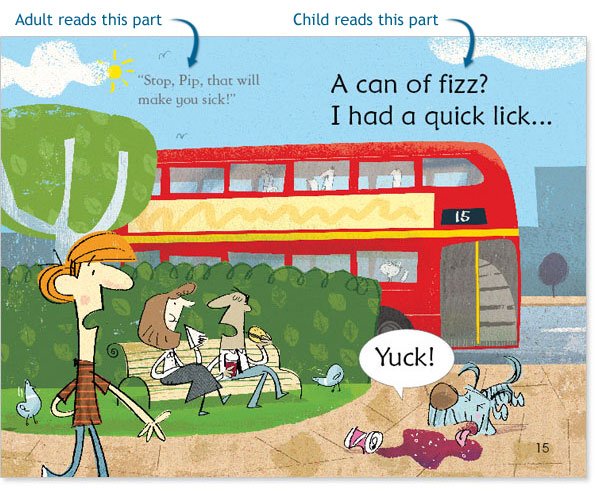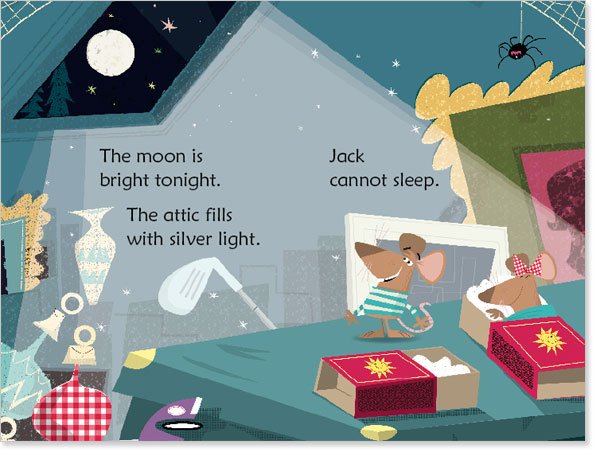Very First Reading – How it works
Usborne Very First Reading takes beginning readers from learning their first letters to reading imaginative stories on their own with minimal support and guidance from an adult. Each book in the series builds on material in the previous books.
Just starting out, books 1 - 7
In the first seven books, adult and child take turns reading, with the child's share becoming more substantial and more challenging in each book.

- Books 1-4 introduce all the letters of the alphabet, in their simplest and most common forms of pronunciation (c as in cat, a as in ant, y as in yell, etc.) in simple one-syllable words. This material is commonly introduced in pre-kindergarten and kindergarten.
- Books 5-8 introduce those sounds in English that are commonly written with two or more letters (ch as in chip, ai as in aim, etc.) This corresponds with material that is commonly introduced and reviewed in pre-kindergarten through first grade.
When these two stages are introduced will depend on your child and on your child’s teacher and school, but the books will ensure plenty of reading and writing practice to develop retention and confidence.
Growing in confidence, books 8 - 15
Starting with Book 8, the child reads the whole story with the adult providing help and support if needed.

- Books 9-13 focus on different patterns of spelling and pronunciation.
- Books 14-15 focus on particularly tricky spelling patterns and longer words.
Ready to read?
- You can sit down to read at any time of day, but choose a time when you can sit quietly without distractions or deadlines.
- Before you start reading, look at the book's cover and title together. What do you think the story is about? What can you see in the picture?
- The story in each book starts on page 4. On each double-page spread, try reading your part first, then give plenty of time for the child's part. Or you might like to let your child read first to get familiar with any new words, so you can both read your parts more fluently.
- To begin with, your child will probably need help to sound and blend the words. Encourage your child to make the letter sound ("t" not "tee" - you can listen to all the letter-sounds in our guide to Pronouncing the phonemes), then read the sounds quickly one after another until your child hears how they come together or blend to make the word: "t – a – p", "t-a-p", "tap".
- Almost all the words in the first book, Pirate Pat, are phonically regular; that is, they are made up of letters with the same, consistent sounds. The only irregular words are "I" and "is". Children generally don't find it difficult to recognize and learn irregular words, provided they are introduced gradually and carefully. The capital "I" on page 11, for instance, looks different from the lower case "i" that your child has already met in "sit" on page 7, so children are not surprised that it should have a different sound. And although "is" ends in a /z/ not a /s/ sound, children are very familiar with the word in speech and soon recognize it on the page. Each book in the series introduces one or two irregular words in this way.
- Your child should be able to read all his or her part of the book just by sounding and blending the individual words; and should not have to guess from the picture or context (although this is a very common instinct and will later be a useful reading skill).
- Give your child plenty of encouragement and praise for successful reading.
- If your child makes a mistake, don't jump in to correct it right away – children will very often correct themselves if you give them the chance. Otherwise, when you get to the end of their sentence or section, go back and look at the problem word, encouraging your child to sound and blend it. Be positive – don't say "That word was wrong" but rather "Let's go back and have another look at this word, shall we?" and then praise them when they get it right.
- If your child is tiring, you don't need to finish the story – it's fine to pause and come back later or another day.
The puzzles
The puzzles after each story are intended to do several things: test comprehension, give further reading practice and provide a fun activity for your child. Generally, the first puzzle checks whether your child has understood the story, for example by asking the child to retell it or match speech bubbles or captions to pictures. The second and third puzzles tend to be more word-based. You will need to read the instructions to your child, and then discuss or check the answers.
When you have finished
It's an excellent idea to read the story several times; your child will gain in fluency and confidence each time. Then, when you feel your child is ready, you can go on to the next book in the series. Don’t rush, though – remember that the fifteen books in the series cover a great deal of material, and practice and confidence are essential at each step. Above all, motivation is vital to successful reading – do what you can to make sure reading is fun, and something your child is really interested in doing.